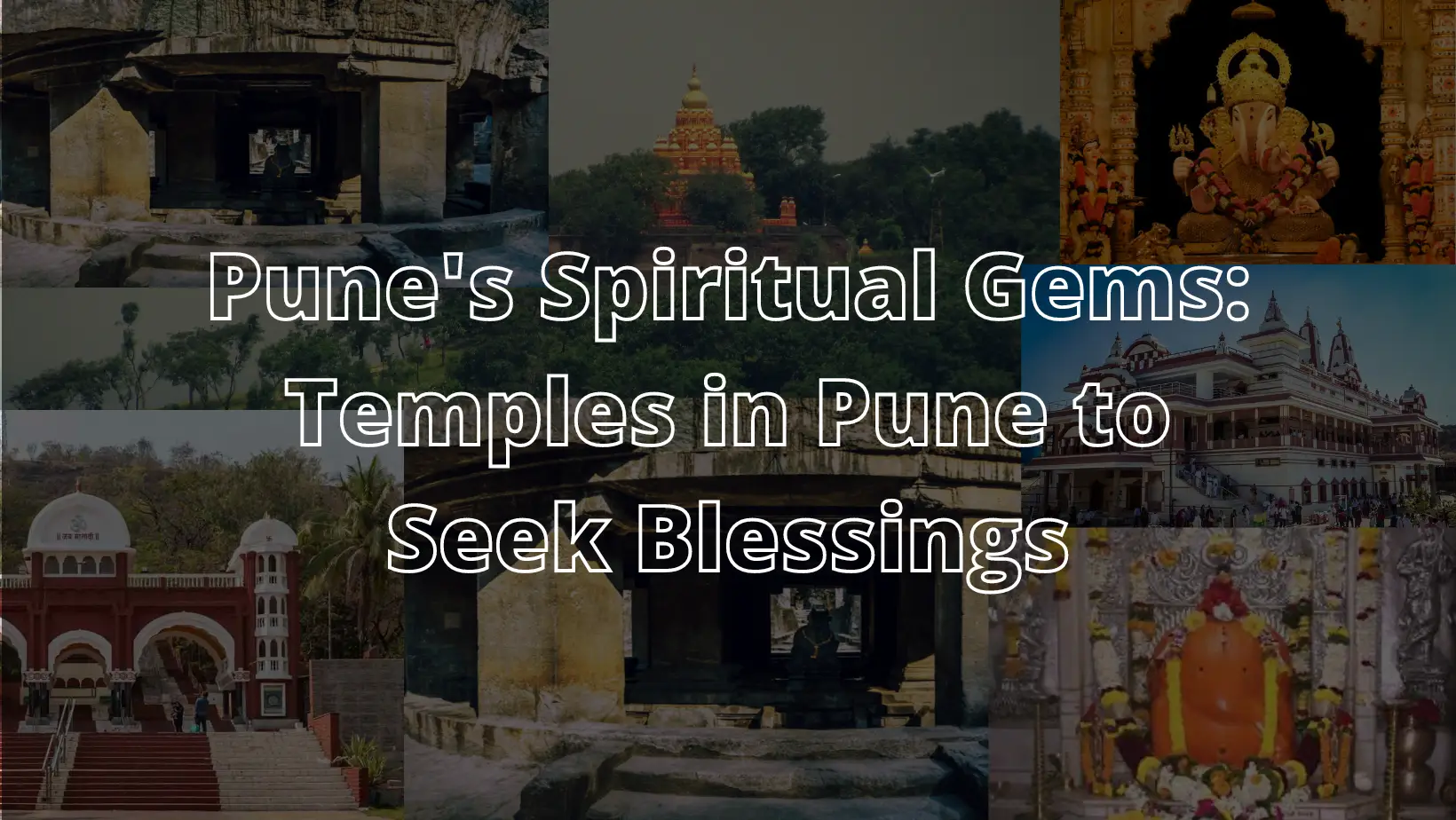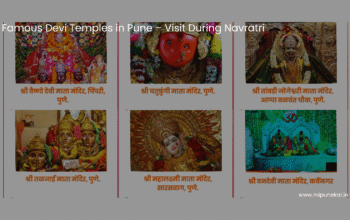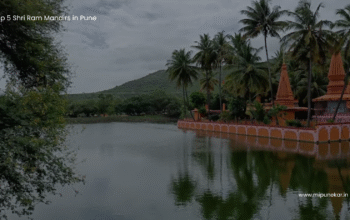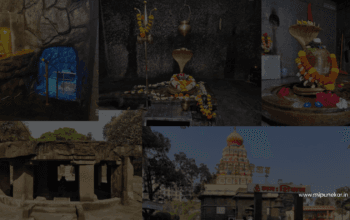Pune, also known as the cultural capital of Maharashtra, is a city that is deeply rooted in its history and culture. It is home to some of the most magnificent and ancient temples in the country. These temples are not only a symbol of the city’s rich cultural heritage but also a reflection of its deep spirituality. People from all over the world come to Pune to seek the blessings of the gods and goddesses that reside in these temples. In this blog, we will take you on a spiritual journey to the top temples in Pune that you must visit to seek blessings and experience the divine aura that surrounds them. So, join us as we explore Pune’s spiritual gems and discover the true essence of this beautiful city.
1. Shreemant Dagdusheth Halwai Ganpati Temple
2. Chaturshringi Temple
3. ISKCON NVCC Temple
4. Parvati Temple
5. Bhuleshwar Temple
6. Pataleshwar Temple
7. Chintamani Ganpati Temple
Chaturshringi Temple: A Serene Retreat in the Heart of Pune
The beautiful and tranquil Chaturshringi Temple, located on a hill in the centre of Pune, is a spiritual haven away from the city’s bustle. One of Pune’s most well-known and venerated temples, it is dedicated to the goddess Chaturshringi, also known as Ambareshwari.
History and Significance
The Chaturshringi Temple is thought to have been constructed during Shivaji’s dominion over the Maratha people. The temple is so named because the hill it stands on has four peaks that resemble the four peaks of a crown. The Hindu goddess Durga, who represents strength, courage, and power, is thought to have appeared as the goddess Chaturshringi.
Architecture and Design
Traditional and contemporary architectural styles are combined to create the temple. The idol of the goddess Chaturshringi, which is constructed of black stone and stands at a height of 4 feet, is housed in the inner sanctum of the temple and is surrounded by elaborate carvings and sculptures at the entry. The main hall of the temple is large and is supported by elaborately carved pillars. The area around the temple is lush and green, and it provides stunning views of the city.
Customs and Rituals
The Navratri festival, which is celebrated with much pomp and fervour, is the finest time to visit the temple because it is available to tourists from early in the morning until late in the evening. To the goddess, worshippers present flowers, coconuts, and sweets in exchange for her favours. Additionally, it is customary at the temple to present the goddess with the unique treat known as “modak,” which is thought to be her favourite.
Advice to Visitors
It is advised to wear modest apparel and take your shoes off before entering Chaturshringi Temple. By strolling up the hill or relaxing in the temple’s garden, visitors can also take in the beautiful splendour of the neighbourhood. There are several food and souvenir merchants close by, and the temple is easily reachable by vehicle or public transportation.
Conclusion
For anyone looking for a spiritual retreat in the centre of Pune, Chaturshringi Temple is a must-visit location. The temple is a genuinely exceptional and rare destination because of its tranquil and peaceful environment, stunning architecture, and amazing vistas. The Chaturshringi Temple is a must-visit location whether you’re a pilgrim seeking blessings or a traveller hoping to take in Pune’s rich culture and history.
ISKCON NVCC Temple: A Spiritual Haven in Pune
The majestic ISKCON NVCC Temple, which is situated in the centre of Pune, emanates a sense of serenity and spirituality. One of Pune’s most well-known and beloved temples, it is devoted to Lord Krishna, the eighth avatar of Lord Vishnu.
History and Significance
The International Society for Krishna Consciousness (ISKCON) constructed the ISKCON NVCC Temple in 2004. The temple is committed to disseminating the message of Lord Krishna’s teachings and is a part of a vast network of temples. The temple is a centre of spiritual activity that draws many believers and tourists from around the world.
Architecture and Design
The temple’s design combines traditional and contemporary elements. The temple’s interiors are filled with elaborate carvings and murals, while the outside is a stunning combination of marble, sandstone, and granite. The main hall of the temple is large and is supported by elaborately carved pillars. The area around the temple is lush and green, and it provides stunning views of the city.
Advice to Visitors
It is advised to dress modestly and take your shoes off before entering the ISKCON NVCC Temple. By strolling through the temple’s garden or relaxing in the courtyard, visitors may also take in the natural beauty of the neighbourhood. There are several food and souvenir merchants close by, and the temple is easily reachable by vehicle or public transportation.
Conclusion
if you’re looking for a spiritual refuge in the middle of Pune, you must visit the ISKCON NVCC Temple. The temple is a genuinely exceptional and rare destination because of its tranquil and peaceful environment, stunning architecture, and amazing vistas. ISKCON NVCC Temple is a must-visit location whether you’re a devotee looking for blessings or a tourist wanting to learn about the rich culture and history of Pune.
Dagdusheth Halwai Ganpati Temple: A Divine Abode in the Heart of Pune
Pune, the hub of Maharashtra’s culture, is renowned for its illustrious past and stunning temples. The Dagdusheth Halwai Ganpati shrine is one such shrine that is particularly dear to Pune residents. This temple, which honours Lord Ganesha, can be found in the centre of the city not far from the crowded Budhwar Peth market.
History and Significance:
Dagdusheth Halwai, a vendor of sweets, erected the Dagdusheth Halwai Ganpati Temple in 1893. After Halwai’s son suddenly fell ill and died, the temple was built as a memorial to Lord Ganesha. The temple is also devoted to Halwai’s teacher, the famous saint Samartha Ramdas, who served as Shivaji, the Maratha monarch, and Halwai’s spiritual mentor.
The walls of the temple are decorated with elaborate carvings and lovely sculptures that combine Mughal and Maratha architectural elements. The gold and precious stone-encrusted idol of Lord Ganesha, also called “Lambodar,” is constructed in the shape of the elephant. Every day, new clothes are also put on the statue, and worshippers present the deity with a variety of treats, fruits, and flowers.
One of Pune’s most well-known temples, the Dagdusheth Halwai Ganpati Temple is frequented by followers of Lord Ganesha from around the world. The Ganesh Chaturthi celebration, which is celebrated in Pune with great fervour and devotion, draws a particularly large audience to the temple.
Attractions
In addition to the primary deity, the temple also contains many miniature representations of various gods and goddesses. A lovely garden and a museum devoted to the life of Dagdusheth Halwai are also part of the temple complex. The museum chronicles the life and accomplishments of Halwai, a philanthropist, social worker, and successful businessman.
The temple’s regular ‘aarti’ (worship service), which is conducted four times every day, is another draw. With the sound of bells and the aroma of incense filling the air, the aarti is a stunning sight. Around the statue of Lord Ganesha, devotees congregate to offer prayers and ask for his blessings on success and fortune.
Conclusion
The Dagdusheth Halwai Ganpati Temple represents Pune’s rich cultural legacy in addition to being a site of prayer. The temple is a must-see for anybody visiting Pune because of its architecture, significance, and history. The temple is open to people of all religions and ideologies and is a symbol of India’s diversity and unity. If you are in Pune, do not miss the chance to visit this divine abode and seek the blessings of Lord Ganesha.
Parvati Temple: A Sacred Oasis in the Heart of Pune
Pune is the cultural centre of Maharashtra and a city rich in tradition and history. The Parvati Temple, which is perched on a hill in the middle of the city, is among the most well-known and revered temples in Pune. It is one of the most popular pilgrimage destinations in the area and is devoted to the goddess Parvati, the consort of Lord Shiva.
History and Importance
The Maratha king Shivaji oversaw the construction of the Parvati Temple, which was completed in the 17th century. The temple is situated atop Parvati slope, a slope that provides a broad view of the city. The temple is renowned for its exquisite carvings, stunning architecture, and historical artefacts. The temple is a representation of Pune residents’ commitment and faith as well as a testimony to Maharashtra’s rich cultural legacy.
The goddess Parvati, who is revered as a representation of adoration, devotion, and motherhood, is the subject of the temple. Smaller shrines to various gods and goddesses, such as Lord Shiva, Lord Ganesha, and Lord Vishnu, are also housed within the temple complex.
Attractions
In addition to the main temple, the Parvati Temple complex has a lot to offer tourists. A lovely garden that surrounds the temple is a well-liked location for family vacations and picnics. There are numerous statues of famous Maratha heroes throughout the garden, including Shivaji, Jijabai, and Sambhaji.
The temple complex also has a museum that displays Pune’s rich cultural heritage. The museum is home to a sizable collection of antiquity-era artefacts, including scrolls, armour, and weaponry. The renowned Maratha king Shivaji’s life and accomplishments are also the subject of a section in the museum.
The annual festival hosted at the Parvati Temple is another popular attraction. The celebration, also known as Parvati Festival or Parvati Pujan, usually takes place in September. Devotees congregate at the temple during the festival to offer prayers and ask the goddess Parvati’s blessings. The temple is decked with lights and flowers.
Conclusion
For everyone travelling to Pune, the Parvati Temple is a must-see attraction. The temple is a well-liked pilgrimage place and a significant cultural icon due to its significance, history, and attractiveness. The temple is a testament to Maharashtra’s rich history and cultural heritage and a representation of the city of Pune’s devotion and religion. If you are in Pune, do not miss the chance to visit this sacred oasis and seek the blessings of the goddess Parvati.
Bhuleshwar Temple: A Magnificent Maharashtrian Heritage Site
Maharashtra is renowned for its extensive history and cultural legacy. It is a country with a long history and culture. One such Maharashtra wonder is the Bhuleshwar Temple, which is close to Pune. It is one of the most well-known and beautiful temples in the area and is devoted to Lord Shiva.
History and Significance:
The Yadava dynasty ruled during the construction of the Bhuleshwar Temple, which was constructed in the thirteenth century. The local mythical figure Bhuleshwar, who is thought to be an avatar of Lord Shiva, is the inspiration for the temple’s name. The temple is renowned for its distinctive architecture, which incorporates components of Islamic and Hindu design.
The temple is perched atop a hill, providing a stunning view of the countryside beyond. The atmosphere is calm and serene, and there are lush green forests all around the temple. Both tourists and devotees visit the temple frequently to take in the beauty and grandeur of this historic wonder.
Attractions
In addition to the main temple, the Bhuleshwar Temple complex has a lot to offer tourists. A lovely garden that surrounds the temple is a well-liked location for family outings and picnics. There are numerous statues of famous Maratha warriors throughout the garden, including Shivaji, Jijabai, and Sambhaji.
A museum that showcases the rich history and culture of Maharashtra is also located within the temple complex. The museum is home to a sizable collection of antiquity-era artefacts, including manuscripts, armour, and weapons. The great Maratha king Shivaji’s life and accomplishments are also the subject of a section in the museum.
The annual festival held at the Bhuleshwar Temple is another thing that makes it famous. Devotees congregate at the temple during the festival to offer prayers and ask Lord Shiva’s blessings. The temple is decorated with lights and flowers.
Conclusion
Anyone interested in ancient history and culture should visit the Bhuleshwar Temple. The temple is a well-liked pilgrimage site and a significant cultural landmark due to its significance, history, and attractions. The temple is a testament to Maharashtra’s rich history and cultural heritage as well as a representation of the region’s residents’ devotion and faith. Do not pass up the opportunity to visit this fascinating heritage site in Maharashtra if you live there and ask Lord Shiva’s blessings.
Pataleshwar Temple: A Marvel of Rock-cut Architecture
India is a country with many different cultures, languages, and religions. It also has some of the most magnificent and historic temples in the entire world. The Pataleshwar Temple in Pune, Maharashtra, India, is one such temple. Rock-cut architecture, which involves carving temples and other structures out of solid rock, is best exemplified by this temple.
History and Significance
During the Rashtrakuta dynasty’s rule in the eighth century, the Pataleshwar Temple was constructed. The temple, which honours Lord Shiva, is one of the oldest rock-cut temples in the nation. The temple is a marvel of prehistoric Architecture because it was cut out of a single rock. People who want to learn more about Pune’s rich history and culture frequently visit the temple, which is situated in the centre of the city.
Architecture and Design
The Pataleshwar Temple, which is made completely of basalt rock, is a magnificent illustration of rock-cut construction. The temple includes a rectangular courtyard that is bordered on three sides by cloisters with cells. The Shiva linga, the temple’s principal deity, is housed in the temple’s central shrine. Shiva, Parvati, Ganesha, and Vishnu are just a few of the gods whose elaborate carvings and sculptures can be found on the temple walls.
The Pataleshwar Temple’s distinctive circular cave, which was cut out of solid rock, is one of its most striking characteristics. The cave is roughly 3.5 metres in height and has a diameter of around 3 metres. It is believed that this cave was used for religious rituals and meditation.
A stunning Nandi mandapa is also present in the temple, and it is situated close to the main shrine. A life-size statue of Nandi, Lord Shiva’s sacred bull, may be found in the Nandi mandapa.
A trip to the Pataleshwar Temple
People who are interested in ancient Indian architecture and history should visit the Pataleshwar Temple since it is a unique experience. The temple is conveniently next to a road and is situated in the heart of Pune. There is no entry fee and the temple is open daily from 8:00 am to 5:30 pm.
In conclusion, the Pataleshwar Temple is a magnificent illustration of traditional Indian Architecture and design. Anyone interested in history and culture must visit the temple because of its beautiful carvings and rock-cut design. Be sure to include the Pataleshwar Temple on your itinerary if you’re travelling to Pune!
Chintamani Ganpati Temple: A Place of Worship and Divine Blessings
India is a country with many different cultures and religions, and it is also the location of some of the most stunning and historic temples in the entire planet. The Chintamani Ganpati Temple in Pune, Maharashtra, India, is one such temple. The temple, which is one of the most potent in the nation, is devoted to Lord Ganesh, the remover of impediments.
History and Significance
The Maratha king Shivaji Maharaj constructed the Chintamani Ganpati Temple in the 17th century. The temple is thought to be one of Maharashtra’s oldest and most renowned temples. Lord Ganesh, who is revered as the God of knowledge, intelligence, and prosperity, is the subject of the temple. It is reported that anyone who seek Lord Ganesh’s blessings at this temple would have their wishes fulfilled because it is a place of enormous spiritual power.
Architecture and Design
Traditional Indian architecture is beautifully displayed in the Chintamani Ganpati Temple. The temple boasts an impressive entrance with elaborate carvings and sculptures. A stunning Lord Ganesh idol made of solid gold is kept in the temple’s main shrine. The approximately 2.5-foot-tall statue is regarded as one of the most stunning images of Lord Ganesh in the nation.
In addition, the temple includes a lovely courtyard that is encircled by cloisters on three sides. The temple’s walls are decorated with beautiful carvings and sculptures of many gods. A stunning Nandi mandapa is also present in the temple, and it is situated close to the main shrine. A life-size statue of Nandi, Lord Shiva’s sacred bull, may be found in the Nandi mandapa.
travelling to the Chintamani Ganpati Temple
For those who are interested in the history and architecture of ancient India, visiting the Chintamani Ganpati Temple is a unique experience. The temple is conveniently next to a road and is situated in the heart of Pune. There is no entry fee and the temple is open daily from 5:00 am to 10:00 night.
During the Ganesh Chaturthi celebration, which is observed in Maharashtra with considerable fanfare, the temple is exceptionally busy. The Lord Ganesh statue is brought out during this event in a large procession that is accompanied by music, dance, and feasting. Visitors have a wonderful chance to experience Maharashtra’s vibrant culture and traditions during the festival.
In conclusion, the Chintamani Ganpati Temple is a magnificent illustration of traditional Indian Architecture and construction. For anybody interested in history and culture, the temple is a must-visit location because of its grand entryway, lovely courtyard, and elaborate sculptures. Be sure to include the Chintamani Ganpati Temple on your itinerary if you’re travelling to Pune!








